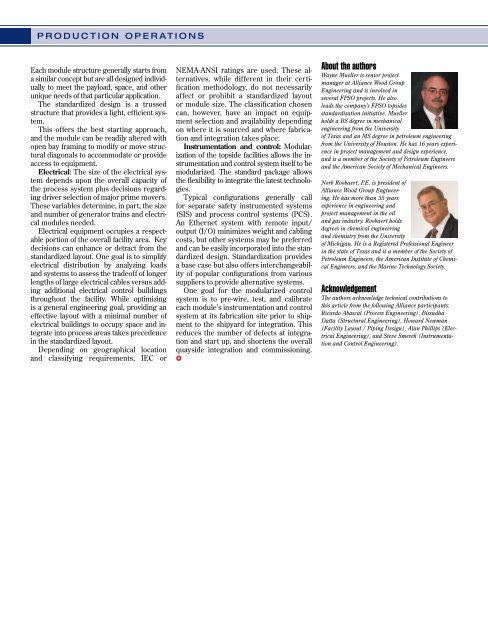Standardization adds value to FPSO topsides - Alliance Wood ...
Standardization adds value to FPSO topsides - Alliance Wood ...
Standardization adds value to FPSO topsides - Alliance Wood ...
Create successful ePaper yourself
Turn your PDF publications into a flip-book with our unique Google optimized e-Paper software.
production operations<br />
Each module structure generally starts from<br />
a similar concept but are all designed individually<br />
<strong>to</strong> meet the payload, space, and other<br />
unique needs of that particular application.<br />
The standardized design is a trussed<br />
structure that provides a light, efficient system.<br />
This offers the best starting approach,<br />
and the module can be readily altered with<br />
open bay framing <strong>to</strong> modify or move structural<br />
diagonals <strong>to</strong> accommodate or provide<br />
access <strong>to</strong> equipment.<br />
Electrical: The size of the electrical system<br />
depends upon the overall capacity of<br />
the process system plus decisions regarding<br />
driver selection of major prime movers.<br />
These variables determine, in part, the size<br />
and number of genera<strong>to</strong>r trains and electrical<br />
modules needed.<br />
Electrical equipment occupies a respectable<br />
portion of the overall facility area. Key<br />
decisions can enhance or detract from the<br />
standardized layout. One goal is <strong>to</strong> simplify<br />
electrical distribution by analyzing loads<br />
and systems <strong>to</strong> assess the tradeoff of longer<br />
lengths of large electrical cables versus adding<br />
additional electrical control buildings<br />
throughout the facility. While optimizing<br />
is a general engineering goal, providing an<br />
effective layout with a minimal number of<br />
electrical buildings <strong>to</strong> occupy space and integrate<br />
in<strong>to</strong> process areas takes precedence<br />
in the standardized layout.<br />
Depending on geographical location<br />
and classifying requirements, IEC or<br />
NEMA-ANSI ratings are used. These alternatives,<br />
while different in their certification<br />
methodology, do not necessarily<br />
affect or prohibit a standardized layout<br />
or module size. The classification chosen<br />
can, however, have an impact on equipment<br />
selection and availability depending<br />
on where it is sourced and where fabrication<br />
and integration takes place.<br />
Instrumentation and control: Modularization<br />
of the <strong>to</strong>pside facilities allows the instrumentation<br />
and control system itself <strong>to</strong> be<br />
modularized. The standard package allows<br />
the flexibility <strong>to</strong> integrate the latest technologies.<br />
Typical configurations generally call<br />
for separate safety instrumented systems<br />
(SIS) and process control systems (PCS).<br />
An Ethernet system with remote input/<br />
output (I/O) minimizes weight and cabling<br />
costs, but other systems may be preferred<br />
and can be easily incorporated in<strong>to</strong> the standardized<br />
design. <strong>Standardization</strong> provides<br />
a base case but also offers interchangeability<br />
of popular configurations from various<br />
suppliers <strong>to</strong> provide alternative systems.<br />
One goal for the modularized control<br />
system is <strong>to</strong> pre-wire, test, and calibrate<br />
each module’s instrumentation and control<br />
system at its fabrication site prior <strong>to</strong> shipment<br />
<strong>to</strong> the shipyard for integration. This<br />
reduces the number of defects at integration<br />
and start up, and shortens the overall<br />
quayside integration and commissioning.<br />
•<br />
About the authors<br />
Wayne Mueller is senior project<br />
manager at <strong>Alliance</strong> <strong>Wood</strong> Group<br />
Engineering and is involved in<br />
several <strong>FPSO</strong> projects. He also<br />
leads the company’s <strong>FPSO</strong> <strong>to</strong>psides<br />
standardization initiative. Mueller<br />
holds a BS degree in mechanical<br />
engineering from the University<br />
of Texas and an MS degree in petroleum engineering<br />
from the University of Hous<strong>to</strong>n. He has 16 years experience<br />
in project management and design experience,<br />
and is a member of the Society of Petroleum Engineers<br />
and the American Society of Mechanical Engineers.<br />
Norb Roobaert, P.E. is president of<br />
<strong>Alliance</strong> <strong>Wood</strong> Group Engineering.<br />
He has more than 35 years<br />
experience in engineering and<br />
project management in the oil<br />
and gas industry. Roobaert holds<br />
degrees in chemical engineering<br />
and chemistry from the University<br />
of Michigan. He is a Registered Professional Engineer<br />
in the state of Texas and is a member of the Society of<br />
Petroleum Engineers, the American Institute of Chemical<br />
Engineers, and the Marine Technology Society.<br />
Acknowledgement<br />
The authors acknowledge technical contributions <strong>to</strong><br />
this article from the following <strong>Alliance</strong> participants:<br />
Ricardo Abascal (Process Engineering), Bissudha<br />
Datta (Structural Engineering), Howard Newman<br />
(Facility Layout / Piping Design), Alan Phillips (Electrical<br />
Engineering), and Steve Smerek (Instrumentation<br />
and Control Engineering).


